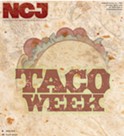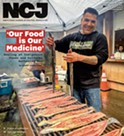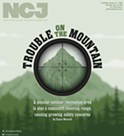Oyster Fest Re-imagined
A virtual festival gives food for thought for future events
By Jennifer Fumiko Cahill [email protected] @jfumikocahill
Courtesy of Meredith Day Klein
The fitting Most Creative Oyster winner for a virtual festival: "Shellfish out of Water" from Sunset Restaurant. .
[
{
"name": "Top Stories Video Pair",
"insertPoint": "7",
"component": "17087298",
"parentWrapperClass": "fdn-ads-inline-content-block",
"requiredCountToDisplay": "1"
}
]
For those of us who don't make it to the blocked-off plaza early enough, the annual Arcata Bay Oyster Festival begins with the distance event of hiking from somewhere in the belly of the Creamery District where we've parked. It can end with the same challenge, though with increased wobbliness and decreased navigational skill.
This year, due to COVID-19 nixing plans for crowding the streets with vendors and visitors, Arcata Main Street's biggest annual event went virtual and required one only to roll over at 10 a.m. and pull up the organization's website or Facebook page to stream the goings on. The decision, according to organizers, was guided by a desire to boost local business in tough times — a welcome mission for local brewers, in particular, who'd been shut out of the festival the year before to the point of creating the Shuck Yeah splinter festival. To that end, the festival team pulled together and reportedly sold out of DIY kits packed with local oysters, festival swag and beverages from local beer, wine and cider producers. It promised a day of live music, educational and cultural programming, as well as the storied Best Oyster competition, albeit from afar.
How that panned out may prove important intel for those in Humboldt and beyond planning the beer and food festivals that typically crowd the calendar all summer and fall. But while Arcata Main Street did not respond to calls or emails from the Journal about the event, we're not without elements to consider. Maybe the pause of the pandemic has given us a moment to step out of the annual cycle and re-imagine what food festivals are and could be. After all, it's worth considering what we might hold onto or leave behind in the theoretical future of "when this is all over."
Viewers tuned in to find dance doyenne Shoshanna resplendent in mermaid-esque crown and gown, hosting the seven-hour show. If the perpetually sparkly queen of the Fairy Festival didn't fall into an exhausted heap of tulle after holding up the conversation alone all day — even while fiddling with screens, links and a trivia contest (full disclosure: I won a commemorative cup) — science needs to study her. The musical acts, too, performed without an audience before a presumed skeleton crew at the closed Jam, providing a live soundtrack to those partying at home with their DIY kits.
The well-produced, pre-recorded chef segments took us into a handful of restaurant kitchens for the familiar, soothing pleasure of watching a pro prepare food currently out of reach. Having the pre-ordered oysters on hand would have helped, so long as you had the foresight to preserve lemons ahead. Chef Trevor Eliason of Mad River Brewing Co. grilled oysters and topped them with brown butter fondue, candied garlic and Meyer lemon confit, birds chirping in the background of the outdoor kitchen all the while. Forrest Samsel, executive chef at Campground, grilled Pacifics over a flame to be served with harissa butter, preserved Meyer lemon relish and pickled shallot. Ryan Clair, executive chef at the Sunset Restaurant made up his forest-inspired "Shellfish out of Water" grilled oyster with fig balsamic, cabernet sauvignon mignonette, kale powder, rose powder, black onion powder, tobiko, fennel and sorrel flower before laying it on a bed of juniper branches. Salt Fish House Executive Chef Jake Alari served his grilled oyster with butter, chives, horseradish, bacon and toasted Parmesan breadcrumbs topped with fennel fronds. Even if you never do anything so elaborate on your own, you came away with a solid education on safely cleaning, shucking and prepping oysters.
Instead of the usual dozen or more judges for whom restaurants and vendors must plate oysters gratis, a panel of five chose the best oyster winners. Journal contributor Wendy Chan, Humboldt Foodies admin (and Journal contributor) Jessica Ashley Silva, event organizer Meredith Klein, Mad River Union columnist Bob Doran and Humboldt County Supervisor Mike Wilson zipped around to each restaurant to sample, rather than awaiting platters on the plaza. In the end, Mad River Brewing Co. won Best Overall Experience for its restaurant presentation and Best Cooked. Most Creative went to Sunset Restaurant, and perennial favorite Sushi Spot captured Best Raw oyster with yuzu vinaigrette, cherry tomato, lime, jalapeño and green onion on the half shell. The smaller, more food-focused panel seems like a model worth sticking with.
Organizers made good on the promise of educational content with pre-recorded interviews with oyster farmers Sebastian Elrite of Aqua Rodeo Farms, Andrew Johnson of Coast Seafoods, Scott Sterner and son Kyle Sterner of North Bay Shellfish and Todd Van Herpe from Humboldt Bay Oyster Co. Along with stories of how they got into the business and anecdotes about massive 2.5- to 3-pound oysters and seals hopping onto boats, we get an oral history of the industry that harkens back to the first Native cultivators. That includes some of what makes Humboldt Bay's oysters sought after — nutrients, the balance of fresh and salt water, sunlight and depth, even summer microalgae — and the fragility of that ecosystem.
In another segment, Wiyot Tribal Chair Ted Hernandez recounts how Wiyot people gathered oysters from the bay and crossed it in dugout canoes for the World Renewal Ceremony in which other tribes, including the Karuk, Yurok, Hupa and Tolowa, also participated. "It was our farm, our grocery store, you know; it was the way we lived." He talked about the cleanup and reclaiming of Tuluwat Island, as well as the tribe's ongoing efforts to bring back traditional plants and the need to bring back the traditional foods that are inextricably tied to both daily survival and ceremony.
After hearing about the patient two-year cultivation of oysters from farmers and their cultural value from Hernandez, it's hard to imagine returning to the high-speed shuck and swallow competition to watch people struggle admirably to keep down their fill and then some. And when we return to crowds and lines, with restaurants and food producers still likely recovering from the pandemic's financial blow, will we need to find less taxing ways for them to participate in a celebration of local food than to pay for costly booths and hustle to make profit? That goes for the oyster competition, too. Like our slow return to restaurants, the experience for festival-goers may have changed too much to go back to a wild binge in the sun, oblivious to the folks making and serving all that food and drink.
That kind of myopic focus on consumption, fun as it is to feast and run, has so far led us to a broken food system that often leaves consumers apart from (and oblivious) to those who grow, harvest and prepare their meals. It would be wise to consider what and who our future celebrations are for — tourists? locals? attendees? producers? businesses? fundraising? — and let that guide us.
This year's approach — awkward as it was in places — certainly lacked the warmth of a face-to-face gathering. But it was also far more mindful of the people and the place feeding us.
Jennifer Fumiko Cahill is the arts and features editor at the Journal and prefers she/her. Reach her at 442-1400, extension 320, or [email protected]. Follow her on Twitter @JFumikoCahill.
Speaking of...
more from the author
-
Hole Food
- Apr 27, 2024
-
SCOTUS on the Homeless, CPH Protest and Local Entertainment
- Apr 26, 2024
-
Look Up for Rooftop Sushi
- Apr 19, 2024
- More »




































